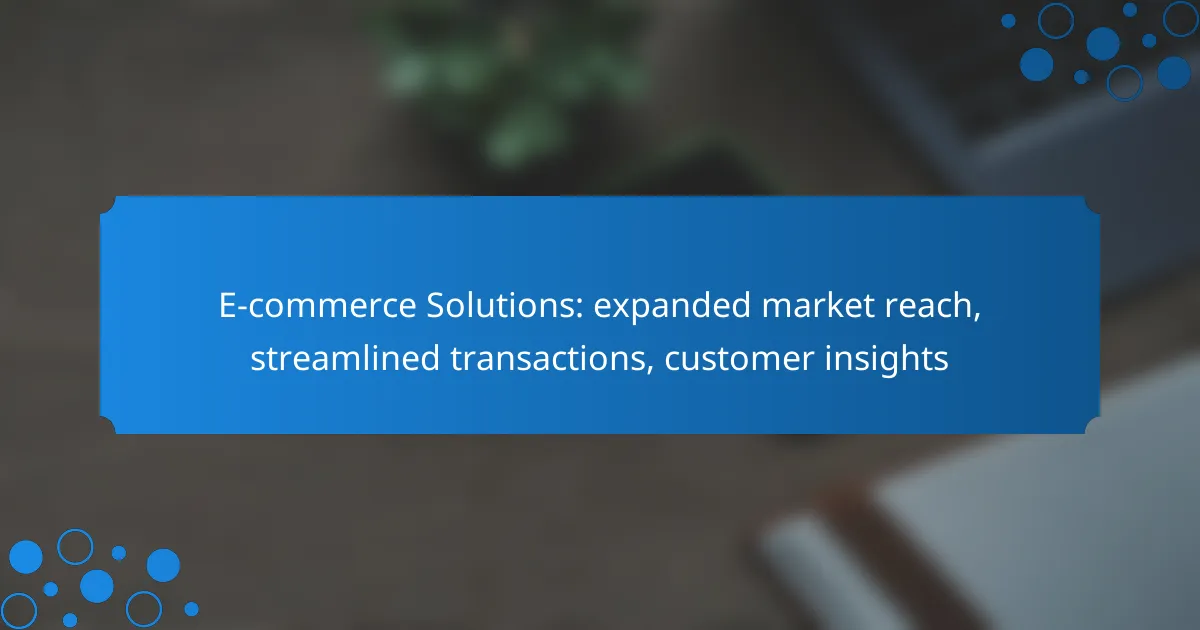In today’s digital landscape, effective e-commerce solutions are essential for businesses aiming to expand their market reach and streamline transactions. By utilizing platforms like Shopify, BigCommerce, and WooCommerce, companies can enhance their operational efficiency and gain valuable insights into customer behavior. These tools not only facilitate seamless payment processes but also open doors to new customer segments and geographical markets.
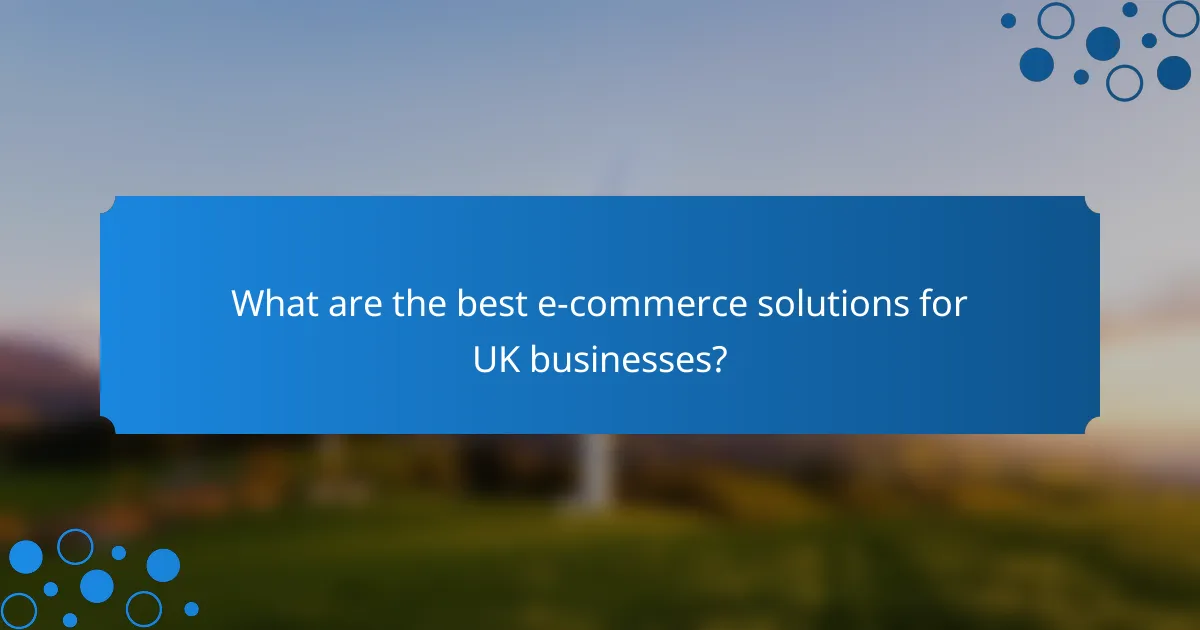
What are the best e-commerce solutions for UK businesses?
The best e-commerce solutions for UK businesses include platforms that enhance market reach, simplify transactions, and provide valuable customer insights. Popular options like Shopify, BigCommerce, WooCommerce, Magento, and Squarespace each offer unique features suited to different business needs.
Shopify
Shopify is a user-friendly platform ideal for small to medium-sized businesses looking to establish an online presence quickly. It offers a range of customizable templates and integrated payment options, making it easy to set up and manage an online store.
Consider Shopify’s transaction fees and subscription costs, which can vary based on the plan you choose. For UK businesses, it supports GBP transactions, making it convenient for local customers.
BigCommerce
BigCommerce is designed for businesses that require scalability and advanced features. It supports a wide range of payment gateways and offers built-in SEO tools to help improve visibility in search engines.
This platform is particularly beneficial for larger businesses or those with high sales volumes, as it has no transaction fees on any plan. UK businesses can take advantage of its multi-currency support, including GBP.
WooCommerce
WooCommerce is a flexible plugin for WordPress that allows businesses to turn their existing sites into fully functional e-commerce stores. It offers extensive customization options and a wide array of plugins for added functionality.
While WooCommerce itself is free, costs can accumulate through hosting, themes, and additional plugins. UK businesses should ensure their hosting provider supports secure payment processing for local transactions.
Magento
Magento is a powerful e-commerce platform suitable for larger enterprises that need a highly customizable solution. It offers robust features for managing complex product catalogs and large volumes of transactions.
However, Magento requires more technical expertise to set up and maintain, making it less ideal for smaller businesses. UK companies should consider the costs associated with hosting and development when choosing Magento.
Squarespace
Squarespace is known for its stunning design templates and ease of use, making it a great choice for creative businesses. It provides built-in e-commerce capabilities, allowing users to sell products directly from their websites.
While Squarespace is user-friendly, it may lack some advanced e-commerce features found in other platforms. UK businesses can benefit from its straightforward pricing structure, which includes hosting and SSL certificates, ensuring secure transactions in GBP.

How can e-commerce solutions expand market reach?
E-commerce solutions can significantly broaden market reach by enabling businesses to sell across various platforms and locations. By leveraging technology, companies can tap into new customer segments and geographical areas that were previously inaccessible.
Multi-channel selling
Multi-channel selling involves using multiple platforms to reach customers, such as online marketplaces, social media, and a dedicated website. This approach allows businesses to engage with different audiences and increase visibility. For example, selling on platforms like Amazon, eBay, and Etsy can attract diverse customer bases.
Consider integrating your online store with social media channels like Facebook and Instagram, where users can shop directly from posts. This strategy can enhance customer engagement and drive sales through familiar platforms.
International shipping options
Offering international shipping can open up new markets and attract customers from around the globe. Businesses should research shipping providers that offer reliable international services and consider factors like cost, delivery times, and customs regulations. Many e-commerce platforms provide built-in tools to calculate shipping costs and manage logistics.
It’s essential to communicate shipping options clearly on your website, including estimated delivery times and any additional fees. Providing free shipping for orders above a certain threshold can also incentivize larger purchases from international customers.
Localized marketing strategies
Localized marketing strategies adapt your messaging and promotions to resonate with specific geographic or cultural audiences. This can include translating content, using local currencies, and tailoring promotions to regional holidays or events. For instance, a campaign for Valentine’s Day may differ significantly between the U.S. and Europe.
Utilizing local influencers or partnerships can enhance credibility and reach within specific markets. Additionally, consider running targeted ads on social media platforms that focus on local demographics to increase relevance and engagement.
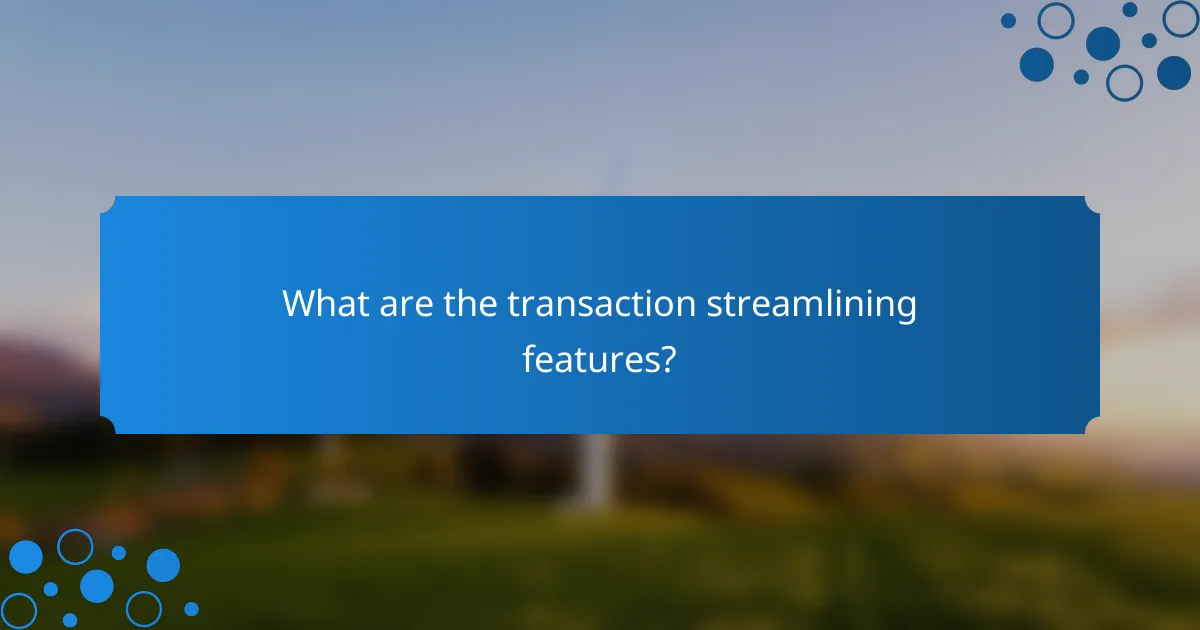
What are the transaction streamlining features?
Transaction streamlining features enhance the efficiency of e-commerce operations by simplifying payment processes, reducing manual tasks, and improving customer experiences. Key functionalities include payment gateway integrations, automated invoicing, and mobile payment options.
Payment gateway integrations
Payment gateway integrations facilitate seamless transactions by connecting your online store to various payment processors. This allows customers to pay using their preferred methods, such as credit cards, digital wallets, or bank transfers.
When selecting a payment gateway, consider transaction fees, supported currencies, and security features. Popular options include PayPal, Stripe, and Square, each offering unique benefits and pricing structures.
Automated invoicing
Automated invoicing streamlines billing by generating and sending invoices without manual intervention. This feature reduces errors and saves time, allowing businesses to focus on other critical tasks.
Look for invoicing solutions that integrate with your e-commerce platform and offer customizable templates. Many tools also provide payment tracking and reminders, which can improve cash flow and reduce late payments.
Mobile payment options
Mobile payment options enable customers to complete transactions using their smartphones or tablets, enhancing convenience and accessibility. This is particularly important as mobile commerce continues to grow globally.
Implementing mobile payment solutions like Apple Pay or Google Pay can increase conversion rates, as they allow for quick and secure transactions. Ensure your website is optimized for mobile use to provide a smooth shopping experience.
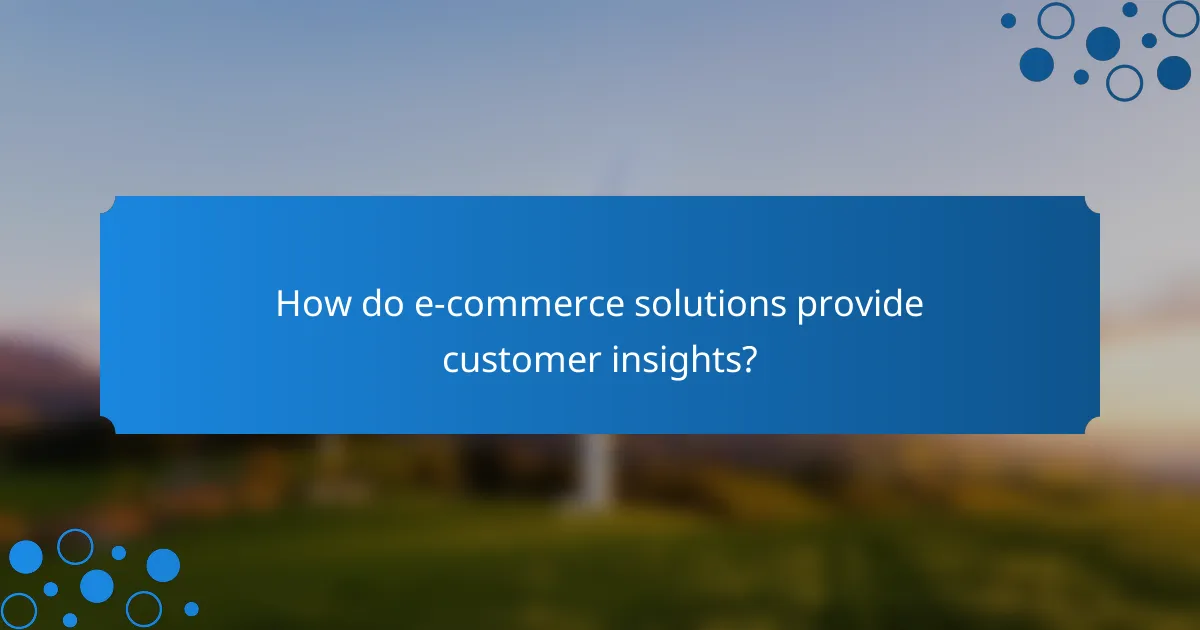
How do e-commerce solutions provide customer insights?
E-commerce solutions offer customer insights by leveraging data analytics to understand consumer behavior, preferences, and trends. This information helps businesses tailor their strategies, improve customer experiences, and ultimately drive sales.
Analytics dashboards
Analytics dashboards are visual tools that compile and display key performance indicators (KPIs) related to customer interactions and sales. They allow businesses to monitor metrics such as conversion rates, average order value, and customer acquisition costs in real-time.
Using dashboards, companies can quickly identify trends and make data-driven decisions. For example, a sudden drop in conversion rates may prompt an immediate review of the website’s user experience or marketing strategies.
Customer segmentation tools
Customer segmentation tools categorize consumers based on shared characteristics, such as demographics, purchasing behavior, or engagement levels. This segmentation enables businesses to create targeted marketing campaigns that resonate with specific groups.
For instance, a retailer might segment customers into categories like “frequent buyers” and “occasional shoppers,” allowing for tailored promotions that encourage repeat purchases. Effective segmentation can lead to higher engagement and improved customer loyalty.
Behavior tracking
Behavior tracking involves monitoring how customers interact with a website or app, including page views, click patterns, and time spent on specific sections. This data provides insights into user preferences and potential friction points in the shopping experience.
By analyzing behavior tracking data, businesses can optimize their websites for better performance. For example, if users frequently abandon their carts at checkout, it may indicate a need for a simpler payment process or clearer shipping information.
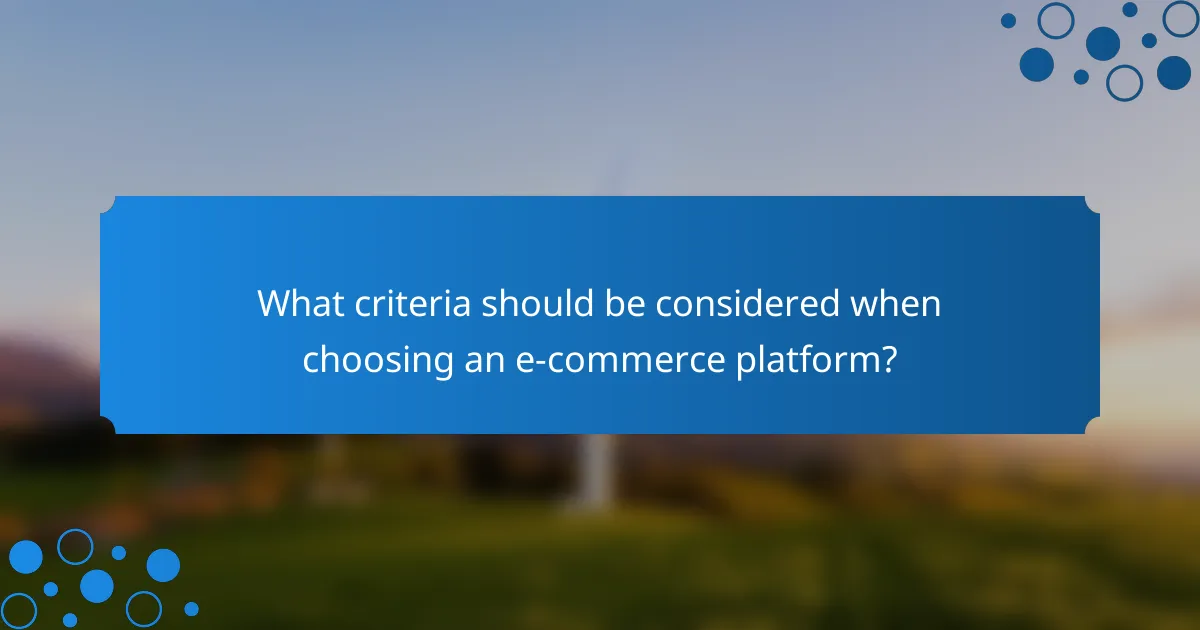
What criteria should be considered when choosing an e-commerce platform?
When selecting an e-commerce platform, key criteria include scalability, integration capabilities, and cost structure. These factors will determine how well the platform can grow with your business, connect with other systems, and fit within your budget.
Scalability
Scalability refers to the platform’s ability to handle growth in traffic and sales without compromising performance. A good e-commerce solution should support increased product listings, higher transaction volumes, and expanding customer bases seamlessly.
Consider platforms that offer flexible pricing plans or tiered services, allowing you to upgrade as your business grows. For example, a platform that can handle thousands of products and high traffic during peak seasons is essential for long-term success.
Integration capabilities
Integration capabilities are crucial for connecting your e-commerce platform with other tools like payment processors, inventory management systems, and marketing software. A platform that easily integrates with popular services can streamline operations and enhance customer experience.
Look for platforms that offer APIs and pre-built integrations with widely used applications. This can save time and reduce the complexity of managing multiple systems. For instance, seamless integration with a CRM can help you better understand customer behavior and improve marketing efforts.
Cost structure
The cost structure of an e-commerce platform includes setup fees, monthly subscriptions, transaction fees, and additional costs for features or integrations. Understanding these costs upfront can help you avoid unexpected expenses as your business grows.
Evaluate whether the pricing model is based on a flat rate, a percentage of sales, or a combination of both. For example, platforms with lower monthly fees might charge higher transaction fees, which could be more expensive in the long run if your sales volume increases. Always calculate potential costs based on your expected sales to make an informed decision.

What are the pricing models for e-commerce solutions?
E-commerce solutions typically employ several pricing models, including subscription-based, transaction-based, and tiered pricing. Each model has its own advantages and considerations, impacting overall costs and scalability for businesses.
Subscription-based pricing
Subscription-based pricing involves paying a recurring fee, often monthly or annually, for access to e-commerce platforms and tools. This model is beneficial for businesses that prefer predictable costs and want to avoid transaction fees.
For example, platforms like Shopify and BigCommerce offer various subscription tiers, ranging from basic plans to advanced packages with additional features. Businesses should assess their needs to choose the right tier, as higher plans often include enhanced functionalities.
Transaction-based pricing
Transaction-based pricing charges businesses a fee for each sale made through the e-commerce platform. This model is advantageous for smaller businesses or those with fluctuating sales, as costs align with revenue.
Commonly, platforms may charge a percentage of the sale, typically ranging from 1% to 3%, plus a fixed fee per transaction. It’s essential to calculate potential costs based on expected sales volume to determine if this model is financially viable.
Tiered pricing
Tiered pricing combines elements of both subscription and transaction-based models. Businesses pay a base subscription fee that includes a certain number of transactions, with additional fees for exceeding that limit.
This model suits growing businesses that anticipate increased sales over time. For instance, a platform might charge a flat fee for up to 100 transactions, then a lower rate for each additional transaction. Understanding the tiers and potential overage fees is crucial for budgeting.
